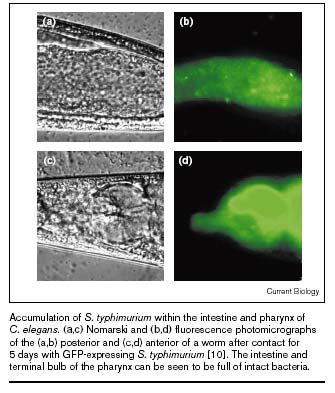
 |
Salmonella typhimurium is another opportunistic human pathogen for which, C.elegans can serve as a good model host. When C.elegans is grown on a lawn of S. typhimurium, the nematode dies over a course of several days due to accumulation of the pathogen in its intestine. The death will still follow even if the worm is exposed to a small inoculum of S. typhimurium for a short period of time (Aballay et al., 2000). The finding that genes important for S. typhimurium pathogenicity in vertebrates also play a role in its pathogenicity in C.elegans open a possibility to take a new genetic approach to study this pathogen. For instance, one important aspect of S. typhimurium is its pH tolerance. Examining strains that harboured mutations in their fur-1 and ompR genes, which were thought to be related to the pathogen's acid tolerance, showed that these strains show a reduction in their pathogenicity in C.elegans and hence, implicated these genes as important S. typhimurium pathogenic factors (Labrousse et al., 2000). |